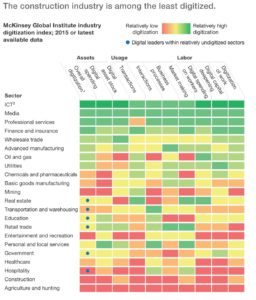Rhumbix: Bringing Analytics and Data Management to the Construction Industry

How one Silicon Valley startup is using digital technology to bring the construction industry out of the Stone Age
The construction industry is among the least digitized sectors in the world. Though many industries have experienced the benefits bestowed by digital innovation, the construction industry remains one of the few contemporary economic pursuits where software is most definitively not yet “eating the world.” As a recent report by McKinsey & Company on the state of the global construction industry highlights, (and as Exhibit 1 depicts) “Contracts do not include incentives for risk…and innovation; performance management is inadequate, and supply chain practices are still unsophisticated.” [1] But if San Francisco-based and veteran-founded startup Rhumbix has a say, digital technologies may soon change the construction status quo.
In terms of economic potential, the construction industry is the world’s second largest sector by annual revenue. [2] However, it suffers from a heavy reliance on paper for items ranging from blueprints, design drawings, and purchase orders to equipment logs, daily progress reports, and punch lists. [3] As projects grow more complex, the efficiencies that could be achieved with digital technologies will only grow. To keep pace with global GDP growth, the world will need to spend approximately $57 trillion on infrastructure by 2030, so there are ample use cases and opportunities for the development, testing, and employment of new digital technologies in the sector. [4]
Enter Rhumbix
Rhumbix was founded by two U.S. Navy veterans who met at Stanford’s Graduate School of Business. The pair initially lamented the construction industry’s heavy reliance on pen-and-paper records and clipboard analysis and decided to found a company that would help industry leaders more accurately account for labor costs and understand how labor resources are utilized in the field. [5] Rhumbix, which raised a $6 million Series A led by vaunted Silicon Valley venture capital firm Greylock Partners, is an example of a recent, but growing phenomenon in venture capital – investors are increasingly looking for opportunities in non-traditional sectors such as construction, oil & gas, mining, and agriculture. Because these industries generally involve asset heavy and capital intensive businesses, startups using digital technologies to disrupt and improve traditional business practices are attractive in their ability to generate venture class returns.
In its most simple mode of use (depcited in Exhibit 2, above), Rhumbix allows construction workers to clock in and clock out via a smartphone application and submit their electronic “timesheets” to their foremen. In the days of yore, foremen compiled timesheets, which could actually be quite complex given that the market wage for an electrician varies widely from that of a welder or heavy equipment operator. The technology has more advanced use cases as well, as its geofencing technology allows for both real-time tracking of workers’ locations on sites and post-job analysis of where workers spent the most time, allowing planners and managers to understand onsite resource allocation. [6] Because construction workers’ salaries are “amalgamated from a variety of different monetary pots,” the ability to understand which workers are performing which tasks and where in a more granular fashion can save hundreds of thousands of dollars through more accurate cost-code accounting. [7]
Rhumbix offers a tiered service model that aims to make and fulfill several different customer promises. At its most basic level, currently priced at $0.50 per worker per day, the software allows for basic daily progress reports, timekeeping, and notekeeping. The “pro” version adds custom export and dedicated phone and email support, while the “enterprise” variant offers Rhumbix’s custom analytics and geolocation capabilities. [8]
The impact of technologies like Rhumbix on the construction industry has the chance to be significant. Construction is a notoriously opaque industry, where cost overruns and “change orders” are frequent. In addition to efficiencies, Rhumbix has the opportunity to provide transparency and allow managers and leaders to understand and communicate to their clients exactly where friction points lie. For example, a sub-contractor could demonstrate to a contractor just why a phase of a project ran over budget, allowing the contractor to clearly and concisely pass that information to all relevant stakeholders.
Can Rhumbix Evolve from Serving Clients to Serving an Industry?
As Rhumbix and other innovators seek to improve the processes and business practices of the construction industry and similar sectors, they would do well to consider creative methods for monetizing the data that they and their customers collect. Rhumbix promises that its technology will allow customers to generate insights from their data, but Rhumbix should also consider who would benefit from industry-wide, anonymized data measuring items like workforce composition and task organization, labor rates, and crew dispersion. Surely there is ample opportunity to take this data, derive best practices, and monetize accordingly.
(763 words)
Sources:
[1] Agarwal, Rajat, Chandrasekaran, Shankar, and Sridhar, Mukund, “Imagining Construction’s Digital Future,” McKinsey & Company Quarterly, June 2016, http://www.mckinsey.com/industries/capital-projects-and-infrastructure/our-insights/imagining-constructions-digital-future.
[2] Chen, Jerry, “Our Investment in Rhumbix,” November 10, 2015, http://www.greylock.com/our-investment-in-rhumbix/.
[3] Agarwal, Chandrasekaran, and Sridhar.
[4] Agarwal, Chandrasekaran, and Sridhar.
[5] www.rhumbix.com, accessed 12 November 2016.
[6] Deamicis, Carmel, “This New Greylock-Backed App Tackles the Unsexy Industry of Construction,” Recode, November 10, 2015, http://www.recode.net/2015/11/10/11620520/this-new-greylock-backed-app-tackles-the-unsexy-industry-of.
[7] Kulkarni, Nitish, “Rhumbix Wants to Be the Palantir for Construction,” TechCrunch, November 10, 2015, https://techcrunch.com/2015/11/10/rhumbix-wants-to-be-the-palantir-for-construction/.
[8] www.rhumbix.com, accessed 12 November 2016.
Exhibit 1:
Agarwal, Chandrasekaran, and Sridhar.
Exhibit 2:
Said, Caroline, “Rhubmix uses data, app to boost efficiency at construction sites,” San Francisco Chronicle, November 10, 2015, http://www.sfchronicle.com/business/article/Rhumbix-uses-data-app-to-boost-efficiency-at-6623319.php.





Great article and interesting topic. I was intrigued by the idea of tracking construction worker locations to analyze resource allocation. Maybe some further analysis of this data would offer opportunities to eliminate wasteful back-and-forth trips on particularity large job sites. With the trip data for each worker, you could use it to model and optimize particular job sites in advance to ensure that too many workers are not in any one particular area. Work would be divided up differently in advance to prevent waste. Also, as mentioned in the article, hopefully Rhumbix can help provide some insight into why certain projects run over budget. I could see this as being very helpful for managers and hopefully they can learn from their mistakes and keep the next project under budget.
Sam, you are the master of the TOM challenges – 2 for 2 on scintillating posts. I’m fascinated to know how many worksites are currently using Rhumbix, and how the company is raising awareness. I would also like to learn how the construction workers themselves like/dislike the platform. As the proverb goes, a bad workman blames his tools, so it will be fascinating to see how Rhumbix gains traction with the workers. After all, I assume you need a smartphone to be able to activate the geo-location services – who will pay for equipping all the workers with technology, and training them?
Great post Sam. Interesting to see how digital technology can potentially disrupt an industry like construction. I was thinking of what other industries might benefit from the implementation of Rhumbix’s technology, for example, could a retailer use it to track how efficiently their sales employees are? Or a car manufacturer to optimize productivity at their factories? My gut feeling is that this technology could have a large number of applications, some of them unrelated to construction. If so, Greylock’s investment looks pretty promising. What do you think?
Really enjoyed your perspective on Rhumbix, Sam! I particularly liked your suggestion that Rhumbhix has the potential to be an industry thought leader by leveraging the data at their disposal.
Given the efficiency gains Rhumbix is generating for companies, do you think they have the ability to be a business model innovation leader as well? It occurs to me that Rhumbix could experiment with a contract structure that allows the company to share in the savings it drives for customers. For example, Rhumbix could adopt a hedge-fund-like model where it charges customers a baseline monthly fee and then a percentage of the costs saved.
Great post, Sam. I enjoyed reading it as I have been spending time in this space and following Rhumbix closely. I wholeheartedly agree with Gregor’s comment in that it is critically important to understand how Rhumbix engages with workers as the quality of its data certainly depends on worker compliance with its procedures. To me, Rhumbix seems to have been developed with a top-down mentality, which could prevent some troubles after all the hype and investment dollars settle. That said, what Rhumbix certainly got right was recognizing a problem and attacking a multi-trillion industry that certainly is stone age. There is tremendous opportunity in this industry for digital disruption, an industry in which 35% of all projects under $500 are late or over budget.
http://www.emersontopquartile.com/z-featureditems/featured-1/the-4-factor-percent-factor
Very interesting post Sam. I didn’t know about Rhumbix and I found very interesting what they are doing in an industry that seems to be walking a couple of steps behind in the digital revolution. Similar to Jose, I was thinking on potential uses outside of the construction arena and I think that there could be many applications for this especially in labor-intensive industries, such as, the mining industry, oil & gas, agriculture and manufacturing. The only problem that I could see here is that the software relies on workers having smartphones, which I believe is a little bit expensive for the company to provide for all, especially in countries outside the US.